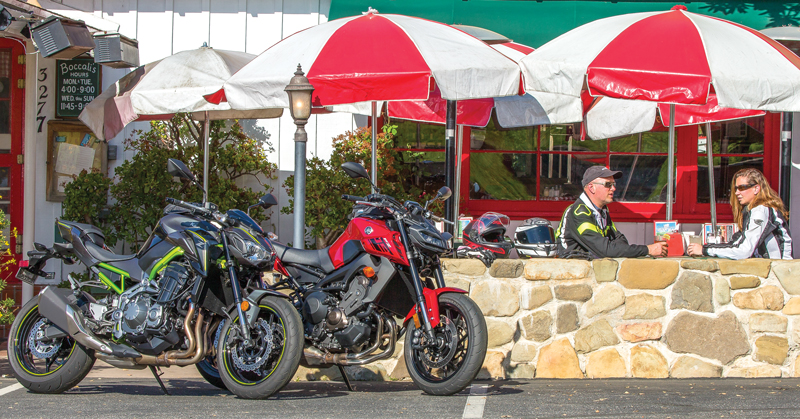
Fans of “naked” or standard sportbikes are currently spoiled for choice. The Japanese Big Four, as well as European brands like Triumph and Ducati, have stepped up to offer a slew of exciting new or updated middleweights, and for the horsepower-hungry there is a tantalizing selection of pavement-rippling, wheel-lofting 1,000cc-plus machines from which to choose.
But for those who are wandering the aisles of the moto-market and thinking, “ah, these are a bit too small…but those are a bit more than what I need,” there are now two options that you might find to be “just right.” Joining the revamped-for-2017 Yamaha FZ-09, Kawasaki has released an all-new Z model that recalls the heyday of the legendary Z1: the Z900.
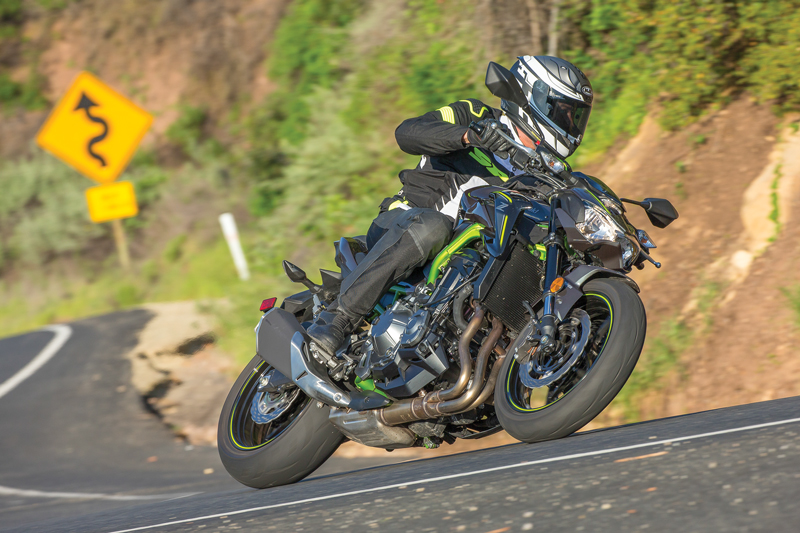
The 2017 Z900 replaces both the discontinued Z800 and the wild Z1000 (which is still available outside the U.S.), and it joins the Z125 Pro and Z650 in the modern Z family. The Z900 is mostly new from the ground up, with a new lightweight steel trellis frame that uses the engine as a stressed member, an extruded aluminum swingarm, a new 948cc in-line four-cylinder engine and new lightweight five-spoke wheels. Kawasaki claims a weight savings of 46 pounds when compared to the Z800, and at a tested wet weight of 462 pounds, it’s also 24 pounds lighter than our 2014 Z1000 test bike.
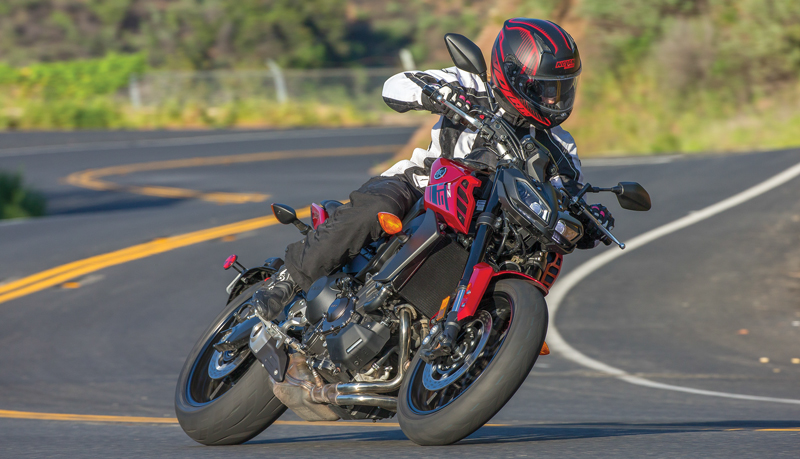
In the other corner, we have the Yamaha FZ-09, the reigning bang-for-the-buck king ever since it was introduced as a 2014 model. For 2017, Yamaha gave the FZ-09 some needed updates, including a fully adjustable fork with new valving that increases compression damping by 83 percent, standard ABS and a remapped YCC-T throttle-by-wire system for smoother response. Although it’s always been a minimalist design, Yamaha managed to tighten the FZ up even more, shortening the subframe (yet managing to extend the passenger seat by half an inch), cleaning up the tail cowl and swapping the plain single headlight for a trick new dual LED assembly reminiscent of the FZ-10. It did gain 13 pounds, largely due to the ABS, but at 426 pounds it’s still a relative featherweight.
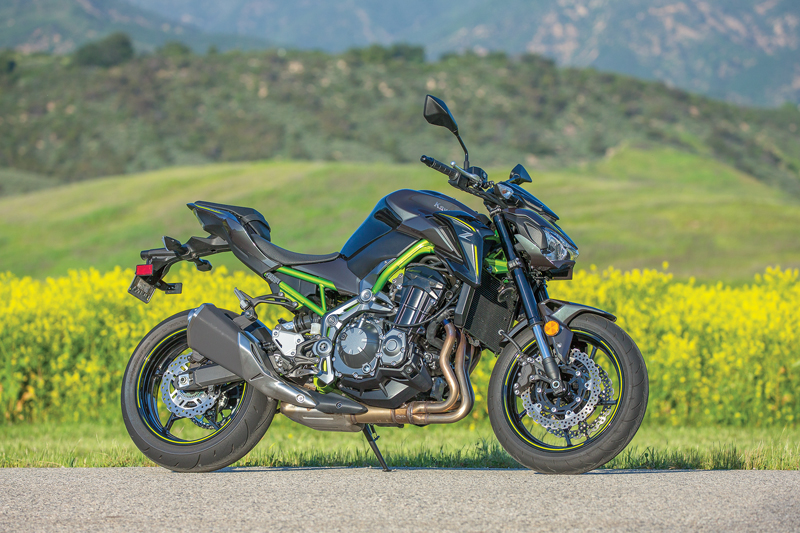
A large part of the FZ-09’s popularity has always been its price, and even with the upgraded fork and standard ABS, the 2017 model only carries an $800 price increase, to $8,999. Compared to the Z900, with its base price of $8,399 (our test bike is the ABS-equipped model, retailing for $8,799), the Yamaha is still a relative bargain, as the Kawi lacks its bells and whistles such as throttle-by-wire and traction control, and its brakes and suspension are not on par with the FZ’s. The upshot is that if you’re one of those riders who is looking for a bike without a bunch of electronic aids, the base model Z900 might be an ideal ride.
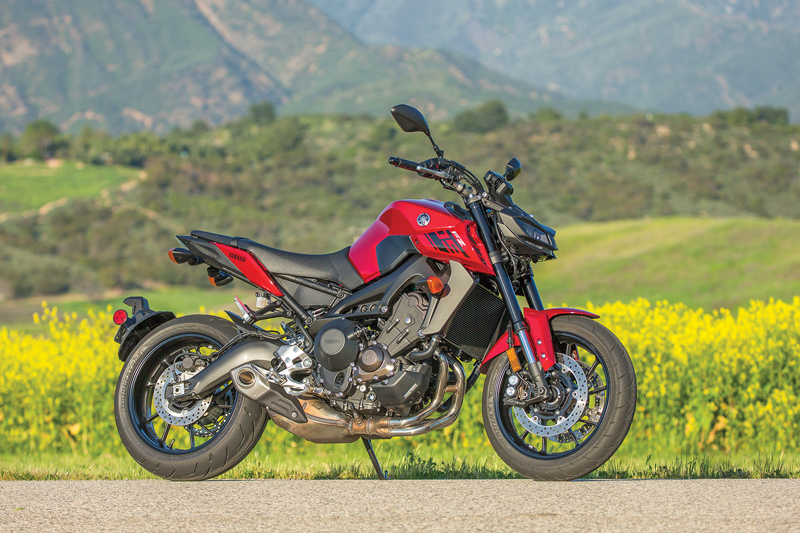
Parked nose-to-nose, it’s immediately clear that these two machines represent two different approaches. The Kawi hunches forward like a predator ready to pounce on its hapless prey, with the low (for a sportbike) 31.3-inch seat dished out between the hulking gas tank and the tall, avian tail. It’s prepared to pursue that prey for quite a while; with our test bike averaging 42.5 mpg out of its generous 4.5-gallon tank, the Z should be good for 191 miles between fill-ups. The Yamaha, meanwhile, looks minimalist and low-slung by comparison. Although its seat is a full inch higher, it’s nearly flat all the way to the taillight, with rounded sides that aid in getting the rider’s feet on the ground, but at the expense of support. The minimalism extends to fuel capacity, with the 3.7-gallon tank good for about 163 miles at a tested average of 44.2 mpg.
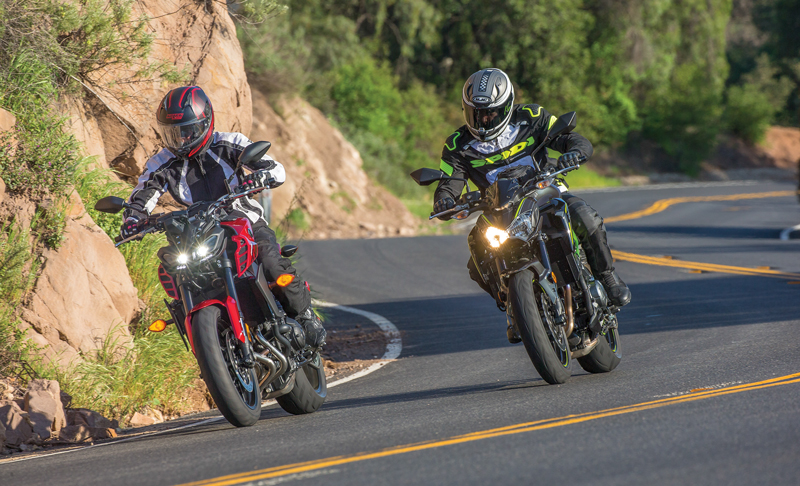
You’ll be happy for the gas stop on both bikes, however, as neither has a seat that is comfortable for more than a couple of hours at a time. Kawasaki does offer an Ergo-Fit comfort seat for the Z900 that not only has thicker padding but also a slightly longer reach to the bars and pegs, but I didn’t find it to be much of an improvement. The rider is more upright on the FZ-09, but the footpegs are located so far back that it can be difficult to feel planted on the bike, and by the end of a full day of aggressive riding, moving around on the saddle and flinging the bike from side to side, my hamstrings were cramping. The Z900 offers a more typical sport standard experience, with the wide handlebar a comfortable reach forward and the rubber-topped footpegs placed directly below the rider’s hips.
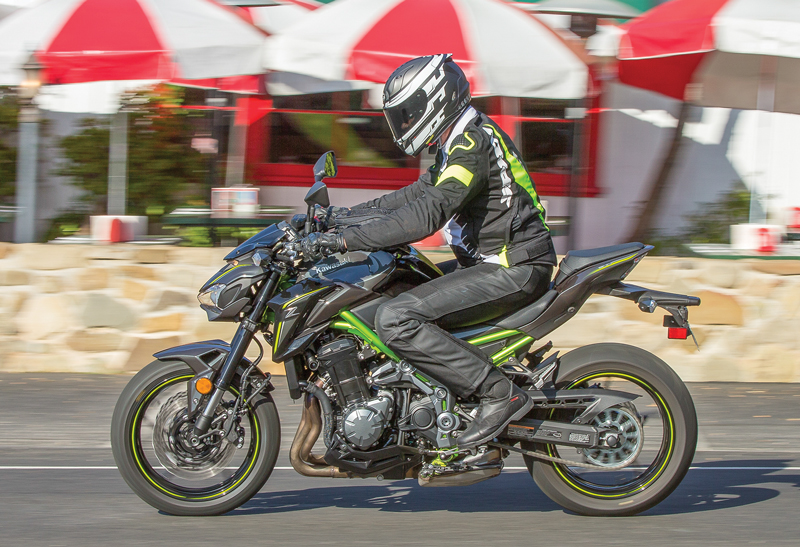
Picking a favorite out of these two machines is not an easy proposition. Taken individually, each one is a competent, fun ride, although each has its own personality.
Both bikes excel at their shared mission—strafing twisties and negotiating urban traffic—but the experience is going to depend on your chosen mount. The Z900 is smooth, forgiving and balanced, with well-calibrated fueling that’s easy to modulate in traffic and on technically demanding roads alike. It’s confidence inspiring, with a willingness to lean over without ever feeling on the edge of control. The new in-line four doles out power in a steady, exhilarating flow, spinning the Jett Tuning dyno to the tune of 113 horsepower and 67.6 lb-ft of torque at the rear wheel. I found myself encouraged to go faster and faster on it, enjoying the intake howl echoing off the canyon walls and the rewarding rush of power from my throttle hand. That is, until things got rough. With a fairly stiff fork (Kawasaki says it’s sprung for an 80-kilogram rider—approximately 176 pounds—and I weigh about 40 pounds less than that) with no adjustment for compression damping, front or rear, the Z900 begins to lose its cool on rough pavement. Making matters worse, while the brakes do their job, they offer very little feedback and lack initial bite. It was never enough to make me feel that skip-a-beat, “uh oh, I’m going in a little hot” feeling, but if the Z was mine, I’d spring for a nice set of HH-rated sintered brake pads that might improve performance and feel.
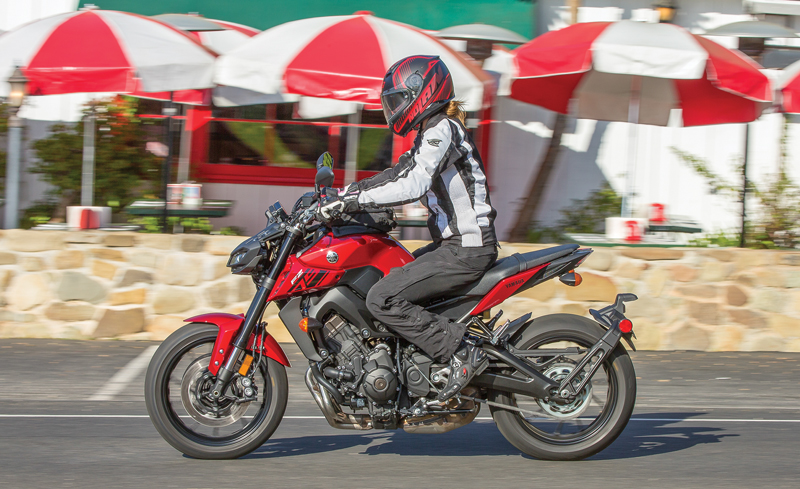
As smooth and polished as the Z900 is, the FZ-09 is mischievous and just a bit rough around the edges. Its raucous Crossplane Concept triple has always been its greatest asset, and Yamaha was wise to leave well enough alone when they gave the FZ its 2017 facelift. But great power requires great control, and the FZ has garnered a reputation for occasionally biting the throttle hand that feeds it with snatchy fueling, particularly in the “A” riding mode, that could be upsetting on technical roads. In an attempt to address this, the 2017 FZ-09’s ECU now shares a map with the more touring-oriented FJ-09, although we still found it too abrupt in both A and STD riding modes. Yamaha was more successful at addressing the FZ’s suspension issues, fitting it with a stiffer, fully adjustable fork (the previous version was only adjustable for preload and rebound damping). Along with standard ABS now fitted to the already excellent brakes, the FZ-09 is like a teenager learning to control and channel his gangly strength.
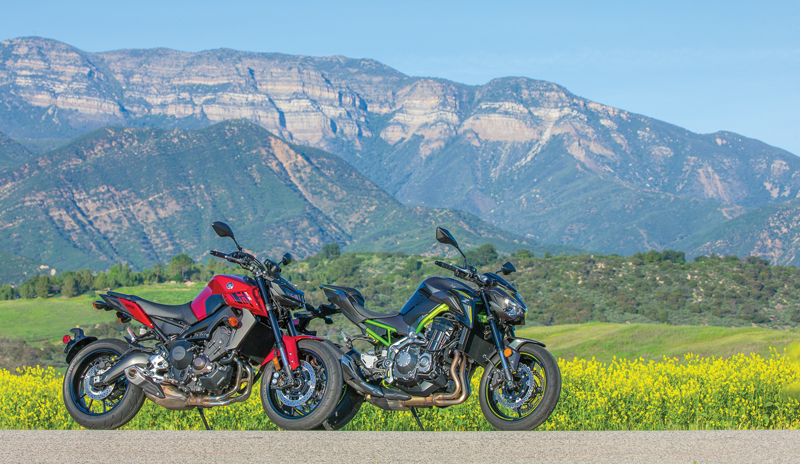
After running through several tanks of gas on each bike, doing everything from highway commuting to stoplight-to-stoplight urban riding, from cruising the sweeping curves of wine country to chasing the breeze up an endless section of first- and second-gear switchbacks, the bikes’ personalities began to shine—flaws and all. What surprised me was my response to those personalities, like going on two (week-long) blind dates.
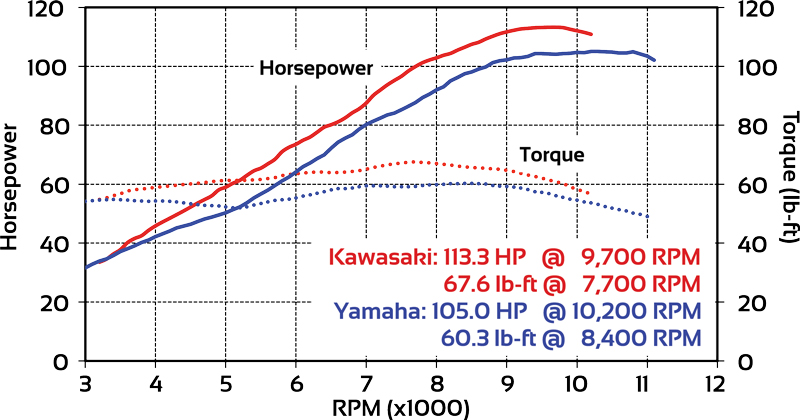 While the FZ’s rip-snorting personality was fun and exciting, I never felt completely comfortable on it—like riding a spirited horse, it always felt like there was a chance it would decide to give me a little toss, just to remind me who was in charge. And while that can be fun in smaller doses, it’s not what I’m looking for in a long-term relationship. By contrast, the Z900 wooed me with its silky smooth, powerful, easy to ride, easy to ride fast personality. While the suspension is not set to my liking, the excellent combination of the stiff chassis and potent engine was enough to tempt me to forgive the flaws and simply enjoy the ride. By the end of our “date,” the upstart Z900 had won me over.
While the FZ’s rip-snorting personality was fun and exciting, I never felt completely comfortable on it—like riding a spirited horse, it always felt like there was a chance it would decide to give me a little toss, just to remind me who was in charge. And while that can be fun in smaller doses, it’s not what I’m looking for in a long-term relationship. By contrast, the Z900 wooed me with its silky smooth, powerful, easy to ride, easy to ride fast personality. While the suspension is not set to my liking, the excellent combination of the stiff chassis and potent engine was enough to tempt me to forgive the flaws and simply enjoy the ride. By the end of our “date,” the upstart Z900 had won me over.
2017 Kawasaki Z900 ABS Specs
Base Price: $8,399
Price as Tested: $8,799 (ABS)
Warranty: 1 yr., unltd. miles
Website: kawasaki.com
Engine
Type: Liquid-cooled, transverse in-line four
Displacement: 948cc
Bore x Stroke: 73.4 x 56.0mm
Compression Ratio: 11.8:1
Valve Train: DOHC, 4 valves per cyl.
Valve Insp. Interval: 15,000 miles
Fuel Delivery: DFI w/ 36mm throttle bodies
Lubrication System: Wet sump, 4.2-qt. cap.
Transmission: 6-speed, cable-actuated wet assist-and-slipper clutch
Final Drive: O-ring chain
Electrical
Ignition: TCBI w/ electronic advance
Charging Output: 336 watts max.
Battery: 12V 8AH
Chassis
Frame: High-tensile steel trellis w/engine as stressed member, cast aluminum swingarm
Wheelbase: 57.1 in.
Rake/Trail: 24.5 degrees/4.1 in.
Seat Height: 31.3 in.
Suspension, Front: 41mm fork, adj. for spring preload & rebound damping, 4.7-in. travel
Rear: Horizontal back-link shock, adj. for spring preload & rebound damping, 5.5-in. travel
Brakes, Front: Dual 300mm petal-type discs w/ opposed 4-piston calipers & ABS (as tested)
Rear: Single 250mm petal-type disc w/ 1-piston caliper & ABS (as tested)
Wheels, Front: Cast, 3.50 x 17 in.
Rear: Cast, 5.50 x 17 in.
Tires, Front: 120/70-ZR17
Rear: 180/55-ZR17
Wet Weight: 462 lbs.
Load Capacity: 407 lbs.
GVWR: 869 lbs.
Performance
Fuel Capacity: 4.5 gals., last 1.0 gal. warning light on
MPG: 90 PON min. (low/avg/high) 39.0/42.5/49.1
Estimated Range: 191 miles
Indicated RPM at 60 MPH: 4,000
2017 Yamaha FZ-09 Specs
Base Price: $8,999
Warranty: 1 yr., unltd. miles
Website: yamahamotorsports.com
Engine
Type: Liquid-cooled, transverse in-line triple
Displacement: 847cc
Bore x Stroke: 78.0 x 59.1mm
Compression Ratio: 11.5:1
Valve Train: DOHC, 4 valves per cyl.
Valve Insp. Interval: 26,600 miles
Fuel Delivery: EFI w/ YCC-T & 41mm throttle bodies
Lubrication System: Wet sump, 3.6-qt. cap.
Transmission: 6-speed, cable-actuated wet assist-and-slipper clutch
Final Drive: O-ring chain
Electrical
Ignition: TCI
Charging Output: 415 watts max.
Battery: 12V 8AH
Chassis
Frame: Controlled fill die-cast aluminum w/engine as stressed member, cast
aluminum swingarm
Wheelbase: 56.7 in.
Rake/Trail: 25 degrees/4.1 in.
Seat Height: 32.3 in.
Suspension, Front: 41mm fork, fully adj., 5.4-in. travel
Rear: Single link-type shock, adj. for spring preload & rebound damping, 5.1-in. travel
Brakes, Front: Dual 298mm discs w/ Monobloc radial mount 4-piston calipers & ABS
Rear: Single 245mm disc w/ 1-piston caliper & ABS
Wheels, Front: Cast, 3.50 x 17 in.
Rear: Cast, 5.50 x 17 in.
Tires, Front: 120/70-ZR17
Rear: 180/55-ZR17
Wet Weight: 426 lbs.
Load Capacity: 383 lbs.
GVWR: 809 lbs.
Performance
Fuel Capacity: 3.7 gals., last 0.74 gal. warning light on
MPG: 91 PON min. (low/avg/high) 33.4/44.2/51.6
Estimated Range: 163.5 miles
Indicated RPM at 60 MPH: 4,000

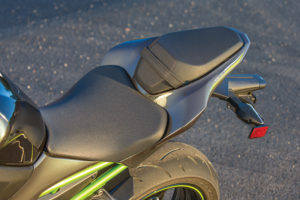
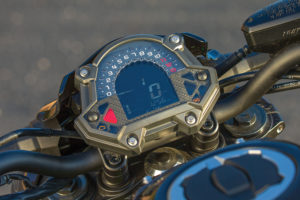
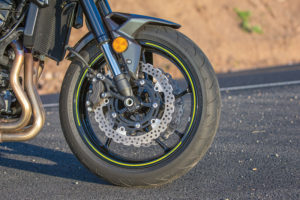
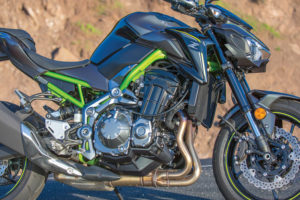
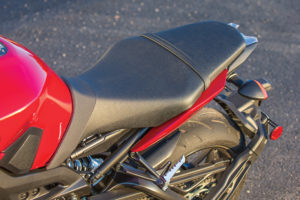
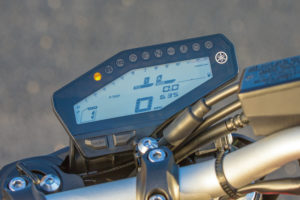
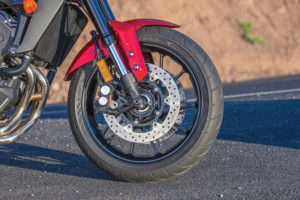
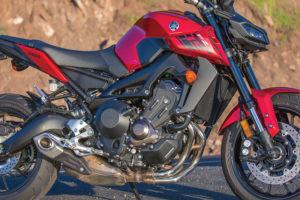
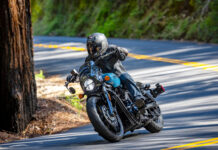






The z900 is the most boring bike I have ever owned. It like riding a sowing machine. Gear ratios way to short, clutch with no feel at all and tiny seat height feels like riding a mini bike. I hate it.
I’ve ridden both and agree,mainly,with the authors conclusions. Yes the MT is flighty and fun but user beware,as with any bike.And after that ride I did find the Z a bit boring but very practical and more stuck to the road.Horses for courses I guess.